Windows and Time
No other aspect of where we live receives as much abuse, neglect, mistreatment, and character assassination as windows. With the exception of below-grade features, windows may top the list of most notable building components that we somehow don’t notice we’re noticing. In an attempt to work through the ongoing restoration of the Schifferdecker house what follows are observations, thoughts, and concerns about the importance of window aesthetics and function over time.

What architecture as an art form depicts differently, and possibly so directly that it goes unnoticed, is the relief of time. In a way, the Schifferdecker house is a machine that molds time. Its unique character creates frameworks into which certain types of experiences are made possible. Beyond even superficiality, the perfected and contrived nature of the Schifferdecker windows are part and parcel in translating relationships: interior–exterior, public–private, and rich–poor. On one level, the visage of the home itself can represent a Joplin of the past juxtaposed to a future Historic Murphysburg Neighborhood on the rise and also the legacy of shifting preferences, technology, and even disaster. In our case, the Schifferdecker windows are one of the best recorders of these marks in time and in many ways open doors/windows to our past, present, and future.

Reflecting upon multiple functions, getting light into an enclosed space is perhaps an unquestionable benefit. As society turned away from kerosene, wale oil and gas lighting towards electric (c. 1880s) the need for windows to supplement inferior lighting was reduced. It could be argued that there’s a connection between the heavy, classic (sometimes over-the-top) Victorian treatment of window openings and the advent of superior interior lighting. Today’s device-centered world marks yet another shifting away from light whereby black-out conditions are sometimes desired. People don’t even know how to open windows and the most obvious function of natural light is rarefied and contradictory to the way some live and work.
In the age-old practice of resisting weather and the rudimentary life-need of shelter, technological advances over time have also infringed upon another original purpose of having holes in buildings—heating and cooling. The Schifferdecker’s double-hung windows were used in order to let cool air in the bottom while hotter air circulated out the pulled-down, top sash. Two original storm windows have been found on site and we have images of storm windows on the home sometime after the turn of the century. It’s unclear whether the storm windows had just not yet been needed or installed in the earliest photos of the house or if they came later. We do believe they existed during our restoration period of 1890-1915. In addition to protection, they also contributed to multiple functions congruent with the original windows’ purposes. Aesthetically, the storm windows represent a lost exterior layer that will greatly alter the view of the entire building. Depth of another layer in relation to the unique and fantastic masonry, stone and terra cotta skin and the configurations of glass will appear quite different than the building we know now.

Contrary to tenants of a “throw-away society”, these windows were designed to be repaired and have been restored a couple times already. I would also argue that replacement is not an intrinsic function—anything can be replaced—but replacement with an exact replica en masse is wasteful and redundant. Our window preservation project was given a generous boost from Bob Yapp, the City of Joplin, Historic Murphysburg, and the Empire Market as we restored nine original windows from the Schifferdecker house in an excellent Bob Yapp Window Restoration Boot-Camp. Currently our window expert, Bob McCarty (also known as The Other Bob, Sir Bob from Fergusland, and other, more PG-rated nicknames), is working on the remaining Schifferdecker windows and reconstructing new storm windows, matching original profiles and our representative examples. He has removed all the art glass which is being restored by local stained glass craftsman Sam Lopp. One of the most challenging aspects in this effort has been the curved sash windows in the tower. The curved storm windows will give the home a “new” look (or one not seen in almost a century). Due to the propensity of corners getting more weather impact and because we want to protect these rare elements, Bob McCarty has sourced historic, redwood lumber in which to build them. The fir for the rest of the storm windows is also historic, old-growth lumber sourced locally.
Bob Yapp Workshop, May 2018























In the spirit of opening windows and taking in a breath of fresh air, seeing through both sides of the window pane, and the lost art of looking up at buildings, architecture has the power to positively influence the way we live and contribute to a better quality of life. Imagine the Schifferdecker tower as a clock tower and the windows are the clocks. If they ever get replaced, that action will leave a mark specific to that era and time. We would still be able to tell the time and read them as clocks (i.e., windows) but something will be “off”. In order to really showcase the look of the building and approach a level of restoration to the period of 1890-1915, windows are as critical as any other detail of the building. It may be time to properly give historic windows credit for all they’ve done for our buildings through the years.
My sincere regards to all prior caretakers of the Schifferdecker house windows.

